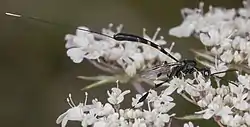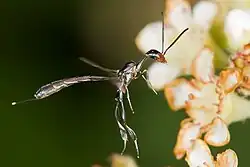| Gasteruptiidae Temporal range: | |
|---|---|
 | |
| Gasteruption jaculator | |
| Scientific classification | |
| Domain: | Eukaryota |
| Kingdom: | Animalia |
| Phylum: | Arthropoda |
| Class: | Insecta |
| Order: | Hymenoptera |
| Superfamily: | Evanioidea |
| Family: | Gasteruptiidae Ashmead 1900 |
| Genera and species | |
|
See text | |

The Gasteruptiidae are one of the more distinctive families among the apocritan wasps, with surprisingly little variation in appearance for a group that contains around 500 species in two subfamilies (Gasteruptiinae and Hyptiogastrinae) and with 6 genera worldwide. They are members of Evanioidea.
Genera
This family includes the following genera in two subfamilies:[1][2][3]
- Gasteruptiinae Ashmead, 1900
- Gasteruption Latreille, 1777
- Plutofoenus Kieffer, 1911
- Spinolafoenus Macedo, 2009
- Trilobitofoenus Macedo, 2009
- Hyptiogastrinae
- Hyptiogaster Kieffer, 1903
- Pseudofoenus Kieffer, 1902
Several fossil species are also known:[4]
- †Hypselogastriinae
- †Hypselogastrion Engel & Wang, 2016 Burmese amber, Myanmar, mid Cretaceous (latest Albian - earliest Cenomanian)
- †Kotujellitinae
- †Kotujellites Rasnitsyn 1990 Taimyr amber, Russia Late Cretaceous (Cenomanian)
- †Kotujisca Rasnitsyn 1991 Andaikhudag Formation, Mongolia, Early Cretaceous (Hauterivian-Barremian)
Description
The propleura form an elongated "neck", the petiole is attached very high on the propodeum, and the hind tibiae are swollen and club-like. The females commonly have a long ovipositor (except in the genus Pseudofoenus), and lay eggs in the nests of solitary bees and wasps, where their larvae prey upon the host eggs, larvae and provisions.[5]
The absence of "teeth" on the crown of the head and the somewhat thickened antennae readily separate these wasps from those in the unrelated family Stephanidae, which also contains very slender wasps with long necks.
Distribution
The smaller of the two gasteruptiid subfamilies, Hyptiogastrinae, has a restricted Gondwanan distribution. Hyptiogaster with 10 species is endemic to Australia, whereas of the 80 species of Pseudofoenus, most are found in Australia, with 2 species in New Zealand, 2 species in South America, 5 species in New Guinea and New Britain, and 3 species in the south-west Pacific (New Caledonia, New Guinea, Fiji and Vanuatu).
Gasteruption is worldwide in its distribution, whereas Plutofoenus, Spinolafoenus and Trilobitofoenus are found in South America.
References
- ↑ "Hymenoptera Online Database". Archived from the original on 2010-10-21. Retrieved 2017-12-14.
- ↑ Jennings, J.T. & Austin, A.D. 2002, Systematics and distribution of world hyptiogastrine wasps (Hymenoptera: Gasteruptiidae). Invertebrate Systematics 16, 735–811.
- ↑ Macedo, A.C.C. 2009, Generic classification for the Gasteruptiinae (Hymenoptera: Gasteruptiidae) based on a cladistic analysis, with the description of two new Neotropical genera and the revalidation of Plutofoenus Kieffer. Zootaxa 2075, 1–32.
- ↑ Jouault, Corentin; Maréchal, Arthur; Condamine, Fabien L; Wang, Bo; Nel, André; Legendre, Frédéric; Perrichot, Vincent (2022). "Including fossils in phylogeny: a glimpse into the evolution of the superfamily Evanioidea (Hymenoptera: Apocrita) under tip-dating and the fossilized birth–death process". Zoological Journal of the Linnean Society. 194 (4): 1396–1423. doi:10.1093/zoolinnean/zlab034. ISSN 0024-4082.
- ↑ Jennings, J.T. & Austin, A.D., 2004. Biology and host relationships of aulacid and gasteruptiid wasps (Hymenoptera: Evanioidea): a review. pp. 187-215. In Rajmohana, K., Sudheer, K., Girish Kumar, P., & Santhosh, S. (Eds.) Perspectives on Biosystematics and Biodiversity. University of Calicut, Kerala, India.
External links
 Data related to Gasteruptiidae at Wikispecies
Data related to Gasteruptiidae at Wikispecies Media related to Gasteruptiidae at Wikimedia Commons
Media related to Gasteruptiidae at Wikimedia Commons- Gasteruption sp. Diagnostic photos of male and female imagines.
- Gasteruptiidae Tree of Life, extensive article.
- Bugguide.net. Information and images
- Encyclopedia of Life